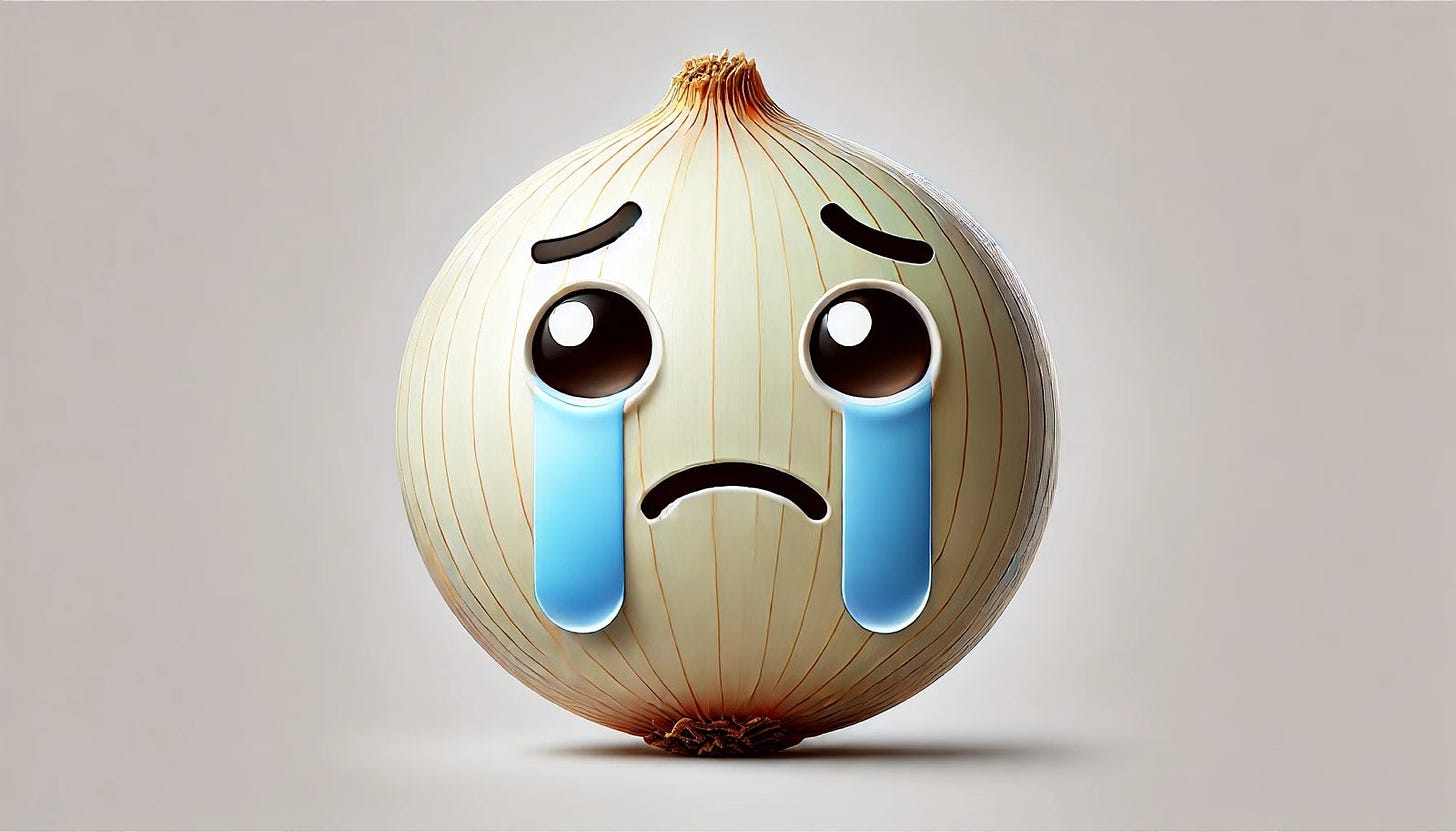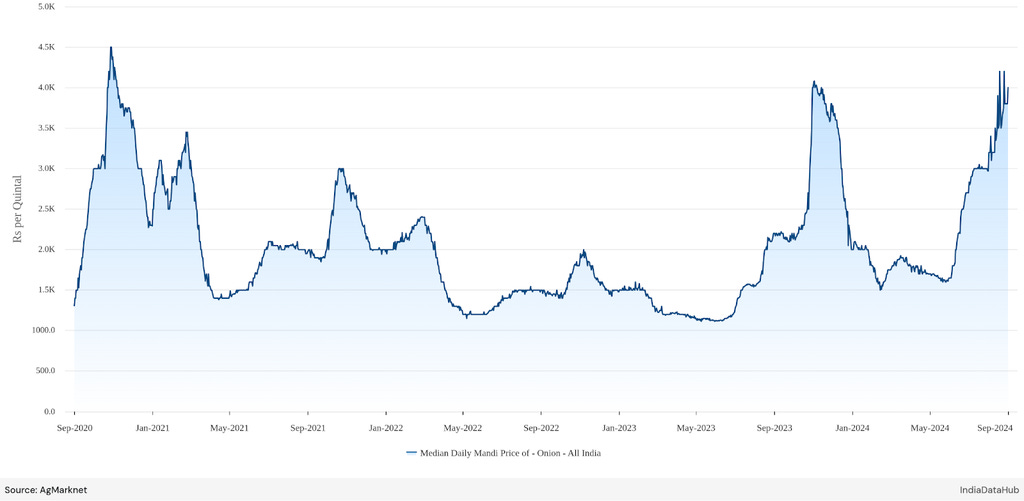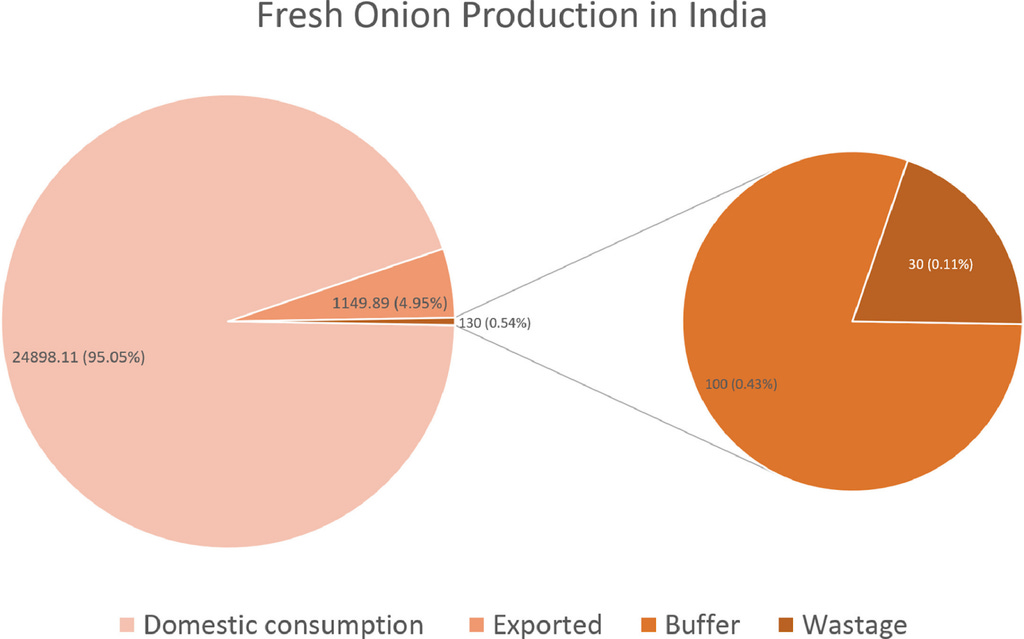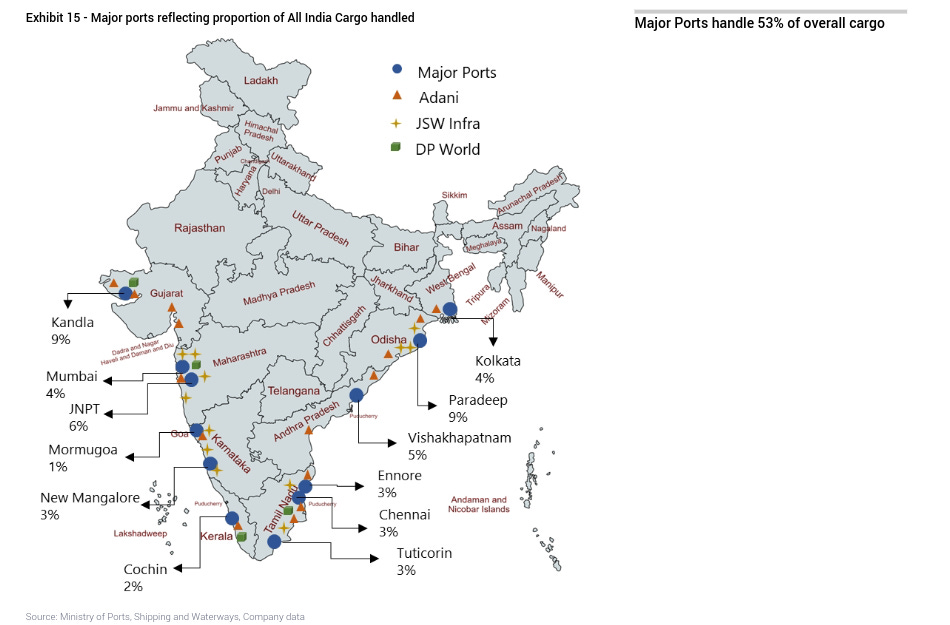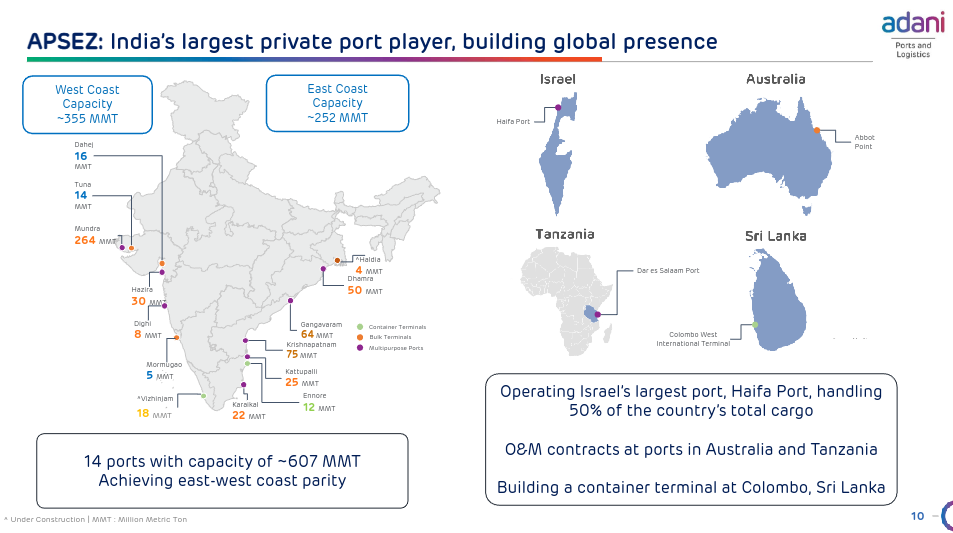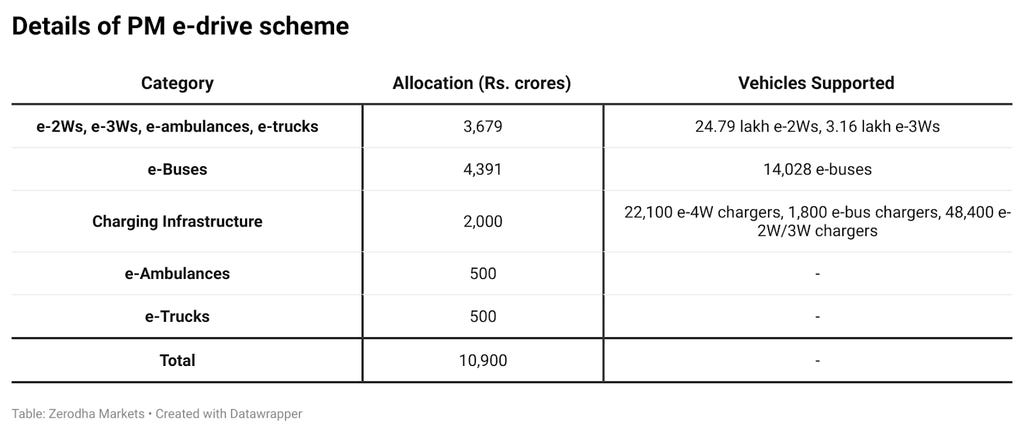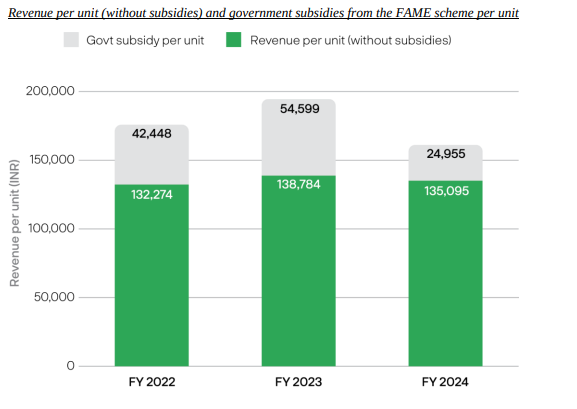Our goal with The Daily Brief is to simplify the biggest stories in the Indian markets and help you understand what they mean. We won’t just tell you what happened, but why and how too. We do this show in both formats: video and audio. This piece curates the stories that we talk about.
You can listen to the podcast on Spotify, Apple Podcasts, or wherever you get your podcasts and video on YouTube.
Today on The Daily Brief:
- Why do onion prices make us cry every time?
- Adani’s plan hit a speed bump
- FAME III replaced by PM E-Drive
Why do onion prices make us cry every time?
If you’ve ever wondered why onions keep making headlines for price hikes, you’re not alone. Every now and then, onion prices shoot up or drop significantly, turning them into a major talking point for both consumers and policymakers. And this year is no different.
In the past few weeks, onion prices have risen sharply, crossing ₹55 per kg in places like Delhi and Chandigarh. Just to give you a comparison, last month, onions in these same markets were priced at around ₹40 per kg.
So, why does this happen so often? And why does the rising price of onions cause such a stir every time?
Let’s break it down by first explaining why this even matters to you:
Onion prices are important because India consumes a massive 13 lakh tonnes of onions every month. Along with tomatoes, onions are one of the most consumed vegetables in the country. So, while onions might seem like just another item on our shopping list, they play a big role in the Indian economy.
Inflation is measured by the Consumer Price Index (CPI), which tracks changes in the price of goods and services. Vegetables make up 6% of the CPI, and out of that, tomatoes, onions, and potatoes together account for 2.2%. So, when onion prices spike, it doesn’t just hit household budgets — it pushes up food inflation too.
This has a domino effect. The government often has to step in by releasing buffer stocks, like they’re doing in Delhi and Mumbai right now by selling onions at a discount. They may also adjust export policies, either restricting imports or exports to bring prices down.
But what’s causing the price rise this time? The monsoon. Heavy rains in Maharashtra, India’s largest onion-producing state, have raised concerns over the harvest. If the rains continue, the harvest could suffer, and onions in storage might also be damaged.
We’re also feeling the effects of unseasonal rains and extreme heat waves from a few months ago. Food supply takes time to adjust, especially after a heatwave like the one we saw this year.
If the rains do impact the harvest, we could see prices rise even more. In key onion markets like Nashik, prices have already jumped by 20-30% due to the hit on the harvest.
But there’s a bit of good news. Maharashtra has reached its sowing target for the monsoon kharif season. The challenge, though, is that the monsoon rains have been uneven across key onion-growing regions, which is still affecting production and prices.
Another issue driving prices up is spoilage. In India, around 20-30% of onions are lost during transport and storage because they’re perishable. When supplies are tight, this wastage becomes a big factor in driving prices higher.
Lastly, there’s the back-and-forth on onion exports. When prices rise, the government usually bans exports to keep more onions in the local market. But once prices stabilize, they lift the ban, and onions start flowing out of the country again. This back-and-forth contributes to the frequent price swings we see.
Right now, there’s no ban on onion exports. But if prices keep climbing or stay high, the government might step in and ban exports again.
So, while onion prices might seem like just a kitchen problem, their ups and downs are a window into the state of India’s agriculture and food supply chain.
Adani’s plan hit a speed bump
Let’s talk about the Adani Group, and we’ve got two interesting stories about it. The first one takes us to Kenya, where Adani’s plans to take over and run Nairobi’s main airport hit a major roadblock this week.
On Tuesday, hundreds of workers at Kenya’s main international airport went on strike, protesting a proposed 30-year lease deal between the Kenyan government and the Adani Group. This strike caused big disruptions, delaying flights and leaving passengers stranded.
So, what’s the deal? Adani has made a $1.8 billion investment offer to lease and operate Kenya’s busiest airport, a key hub in the region.
However, airport workers and unions are worried about possible job losses and handing over control of such a strategic national asset to a foreign company. There are also concerns about how transparent the bidding process has been.
By Wednesday evening, the strike ended after the government promised that workers would have a say in the final deal. But this situation shows the kind of hurdles Adani faces as it pushes for global expansion.
The company has been rapidly expanding its airport business, now running seven major airports in India. Its move into Kenya is a clear sign that Adani wants to become a global player in airport management. But, as we’ve seen, breaking into new markets can come with challenges.
Now, for the second story — Adani’s massive port projects. This one needs a little more background, so stick with us.
India has over 200 ports along its 7,500 km coastline, handling around 1.5 billion tonnes of cargo every year. But here’s the catch — India’s ports are only running at about 60% capacity, and most of them can’t handle the world’s biggest ships because they aren’t deep enough.
Source: Jefferies
That’s where Vizhinjam, Adani’s ambitious deepwater port project in Kerala, comes in. Located near India’s southern tip, this port is in a prime position to tap into international shipping routes.
So why is Vizhinjam important? It’s all about location, depth, and competition with Sri Lanka’s Colombo Port.
Right now, about 75% of India’s transshipped cargo is handled by ports outside India. Of that, Colombo, Singapore, and Malaysia take care of more than 85%, with Colombo alone handling 45%. The reason? Most Indian ports just aren’t deep enough to accommodate the mega container ships. If we handled this cargo ourselves, it could save us around ₹1,500-2,000 crore each year.
Now, here’s a quick breakdown of transshipment: Think of massive container ships — they’re the size of multiple football fields. These giants can only dock at a few deep ports. So, they stop at places like Colombo or Singapore, offload their cargo, and smaller ships pick it up to distribute to other regional ports. It’s like a giant game of pass-the-parcel on the seas.
Vizhinjam, with its natural depth of 20-24 meters, can easily handle the world’s largest vessels. This could help India bring back a lot of the business that’s currently going to Colombo.
Here’s something interesting: Adani isn’t just competing with Colombo, they’re also investing there. In 2021, Adani signed a deal to develop and run the West Container Terminal at Colombo Port, with a $700 million project where Adani holds a 51% stake.
This dual strategy — building Vizhinjam while investing in Colombo — shows Adani’s ambition to dominate regional shipping.
But back to Vizhinjam. After delays and controversies since Adani won the contract in 2015, things are finally moving. In June this year, Vizhinjam welcomed its first commercial vessel, marking the start of operations at India’s first custom-built transshipment port.
Momentum is picking up fast. By September, trial operations at Vizhinjam were in full swing. The port has already hosted several large vessels, including ships with drafts of up to 16.5 meters, some of the deepest ever for Indian ports.
This is a big win for India. Vizhinjam’s natural depth — over 18 meters, going up to 20 meters in some areas — allows it to handle the world’s largest container ships without costly dredging. Its prime location on major international shipping routes makes it a serious player in global transshipment.
The world’s biggest shipping lines are taking notice. Mediterranean Shipping Company, the global leader in container shipping, has already sent five ships to Vizhinjam during trial operations. There are even reports that MSC and Adani are discussing a partnership, with MSC potentially becoming an anchor customer for the port.
Adani Ports plans to invest $1.2 billion to boost Vizhinjam’s capacity, aiming for an annual capacity of 6.2 million TEUs. This investment is part of Adani’s larger plan to dominate India’s port sector.
Adani Ports is already India’s biggest private port player, handling 27% of the country’s total cargo and a whopping 46% of container traffic. That’s a huge leap from just 14% market share in 2015, and it’s gone from running two ports in 2011 to 14 today. Ports are a capital-heavy business, and Adani is playing the long game.
Now, let’s quickly touch on something else about Adani’s Colombo port project.
In November 2023, the U.S. International Development Finance Corporation (DFC) announced a $553 million loan for the Colombo West International Terminal, the joint venture where Adani holds a 51% stake. The rest is owned by local partners and the Sri Lankan government.
Why does this matter? It’s not just about financing a port. This move is seen as part of a larger strategy to counter China’s growing influence in the region.
China has been heavily investing in ports across the Indian Ocean as part of its Belt and Road Initiative. In fact, China has some level of involvement in at least 17 ports in the Indian Ocean region, including Sri Lanka. For example, China holds a 99-year lease on Hambantota port because Sri Lanka couldn’t repay its loans.
So, when the U.S. backs an Adani project in Colombo, it’s not just about the port — it’s also about pushing back against China’s influence in the region.
For Adani, this U.S. backing is a big deal. It’s not just about the funding; it’s a vote of confidence in their ability to handle large infrastructure projects. The Colombo West Terminal isn’t just a port project — it’s a strategic move in the larger game of regional influence.
And the timing couldn’t be better for India. Colombo is facing congestion due to the Red Sea crisis and other geopolitical uncertainties. Vizhinjam has a real chance to establish itself as a major regional hub.
If Vizhinjam can attract the major shipping lines and prove its efficiency, it could shift trade patterns in the Indian Ocean. It’ll be fascinating to see how these projects play out and whether they can offer an alternative to China’s growing network of ports in the region.
FAME III replaced by PM E-Drive
The Indian government recently introduced the PM E-Drive scheme, which is essentially the FAME III policy rebranded with a new name. This initiative comes with a significant budget of ₹10,900 crore for a two-year period.
We’ve talked about EV policies and the FAME scheme quite a bit, including in our Monday edition, “Government vs Government on EVs.” To recap:
- In 2015, India launched the Faster Adoption and Manufacturing of Hybrid and Electric Vehicles (FAME) scheme, with ₹895 crore aimed at boosting EV adoption and manufacturing.
- FAME II came along in 2019 with a much bigger budget of ₹11,500 crore, targeting the sale of around 15 lakh electric vehicles across different categories.
- As FAME II was wrapping up, the government introduced a temporary scheme, the Electric Mobility Promotion Scheme (EMPS), with a ₹500 crore budget to hold things over until a new subsidy program could be rolled out.
Interestingly, just before the PM E-Drive announcement, Union Transport Minister Nitin Gadkari hinted that EV subsidies might not be needed anymore. He pointed out that with rising demand and production, costs were coming down naturally, so government help might not be required as much. Gadkari also stressed India’s focus on developing affordable, homegrown EV tech and mentioned the already low 5% GST on electric vehicles, compared to the hefty 48% on hybrid cars.
So, with all that in mind, why has the government decided to continue with subsidies through the PM E-Drive scheme, despite Gadkari’s comments? The answer isn’t entirely clear.
One of the biggest surprises is that electric cars are no longer eligible for subsidies. Why? It’s possible the government feels the same way as Nitin Gadkari, that EVs are already competitive with petrol and diesel cars in terms of price.
Instead, the focus has shifted to two-wheelers, three-wheelers, buses, and even ambulances. The scheme has allocated ₹3,679 crore to promote two-wheelers, three-wheelers, ambulances, and trucks, with the goal of incentivizing nearly 25 lakh e-two-wheelers and over 3 lakh e-three-wheelers.
Public transport is also a big focus. Nearly ₹4,400 crore has been set aside to help roll out more than 14,000 electric buses, pushing for greener public transport.
But here’s the catch: while FAME II was a five-year plan, PM E-Drive is only set to last two years. That’s a pretty aggressive timeline to achieve the intended goals.
The exact details of how the subsidies will work under PM E-Drive aren’t fully clear yet. But let’s take a quick look at how subsidies usually affect the total cost of ownership (TCO) for electric vehicles, using data from Ather’s recent IPO filing.
Even without subsidies, the TCO of an electric two-wheeler (E2W) in 2024 was about 37% lower than a comparable petrol scooter, assuming 8,000 km of annual usage over a 7-year period. With subsidies, that cost difference jumped to 55%.
These numbers will change under the new PM E-Drive scheme, but it gives you a general idea. As battery tech improves and production ramps up, the TCO advantage for E2Ws is expected to grow, even without subsidies.
Something else worth noting: from FAME I to FAME II, the subsidy per vehicle actually decreased. The shift moved from a flat amount to a battery capacity-based subsidy, capped at 40% of the vehicle’s cost. So, in many cases, FAME II offered less subsidy than FAME I.
Source: Ather Energy DRHP
But there’s one key improvement with PM E-Drive — transparency. Buyers will now get an Aadhaar-authenticated e-voucher at the time of purchase, clearly showing the subsidy amount. This makes it easier for people to see exactly how the government is helping lower the cost of their EVs.
The PM E-Drive scheme marks an important step in India’s electric vehicle journey. By allocating substantial funds to specific vehicle categories and charging infrastructure, the government is betting on a more targeted approach to speed up EV adoption.
But this also raises a few important questions:
- Is the two-year timeframe enough to create lasting change in India’s transportation landscape?
- How will the exclusion of electric cars from subsidies impact the broader EV market?
Only time will tell how this policy plays out, and we’ll be watching closely as it unfolds.
Thank you for reading. Do share this with your friends and make them as smart as you are ![]()
If you have any feedback, do let us know in the comments
